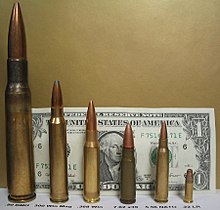
Back عيار Arabic Çap Azerbaijani Калібр Byelorussian Калібр BE-X-OLD Калибър Bulgarian ক্যালিবার Bengali/Bangla Kalibr (armoù-tan) Breton Kalibar BS Calibre Catalan کالیبەر CKB
This article includes a list of general references, but it lacks sufficient corresponding inline citations. (September 2014) |



In guns, particularly firearms, but not artillery, where a different definition may apply[citation needed], caliber (or calibre; sometimes abbreviated as "cal") is the specified nominal internal diameter of the gun barrel bore – regardless of how or where the bore is measured and whether the finished bore matches that specification.[1] It is measured in inches or in millimeters[citation needed].[2] In the United States it is expressed in hundredths of an inch; in the United Kingdom in thousandths; and elsewhere in millimeters. For example, a US "45 caliber" firearm has a barrel diameter of roughly 0.45 inches (11.43mm).[citation needed] Barrel diameters can also be expressed using metric dimensions. For example, a "9 mm pistol" has a barrel diameter of about 9 millimeters. Since metric and US customary units do not convert evenly at this scale, metric conversions of caliber measured in decimal inches are typically approximations of the precise specifications in non-metric units, and vice versa.
In a rifled barrel, the distance is measured between opposing lands or between opposing grooves; groove measurements are common in cartridge designations originating in the United States, while land measurements are more common elsewhere in the world. Measurements "across the grooves" are used for maximum precision because rifling and the specific caliber so measured is the result of final machining process which cuts grooves into the rough bore, leaving the "lands" behind.
Good performance requires a concentric, straight bore that accurately centers the projectile within the barrel, in preference to a "tight" fit which can be achieved even with off-center, crooked bores that cause excessive friction, fouling and an out-of-balance, wobbling projectile in flight.
Calibers fall into four general categories by size:
- miniature-bore historically refers to calibers with a diameter of 0.22 inches (5.6 mm) or smaller
- small-bore refers to calibers with a diameter of 0.32 inches (8.1 mm) or smaller
- medium-bore refers to calibers with a diameter of 0.33 inches (8.4 mm) to 0.39 inches (9.9 mm)
- large-bore refers to calibers with a diameter of 0.40 inches (10 mm) or larger
There is much variance in the use of the term "small-bore", which over the years has changed considerably, with anything under 0.577 inches (14.7 mm) considered "small-bore" prior to the mid-19th century.
- ^ Brown, Edmund G. (2009). Handgun Safety Certificate. West Sacramento, California: California Department of Justice. p. 52.
- ^ Barnes, Frank C. (2016). Woodard, W. Todd (ed.). Cartridges of the World: A Complete and Illustrated Reference for More than 1500 Cartridges (15th ed.). Iola, Wis.: Krause Publications. p. 9. ISBN 978-1440246425. OCLC 934886116.
© MMXXIII Rich X Search. We shall prevail. All rights reserved. Rich X Search